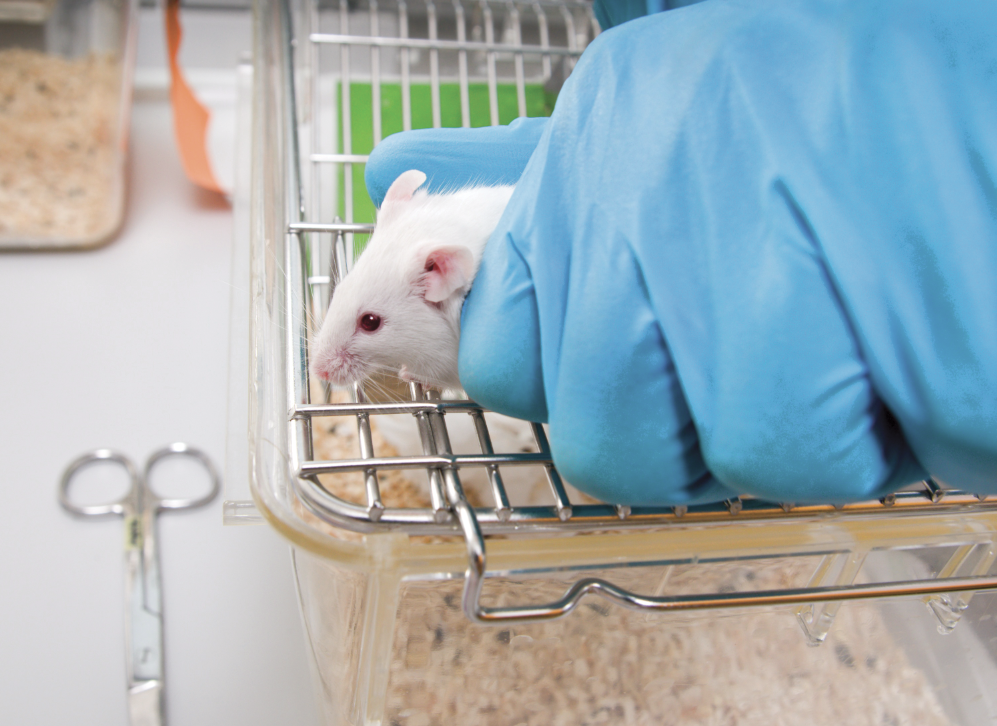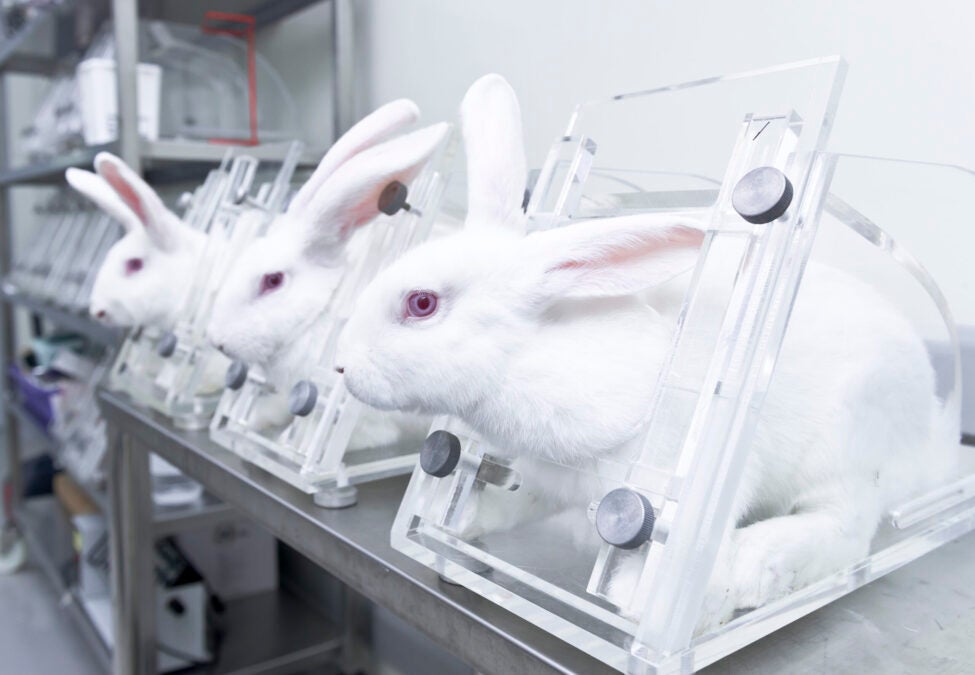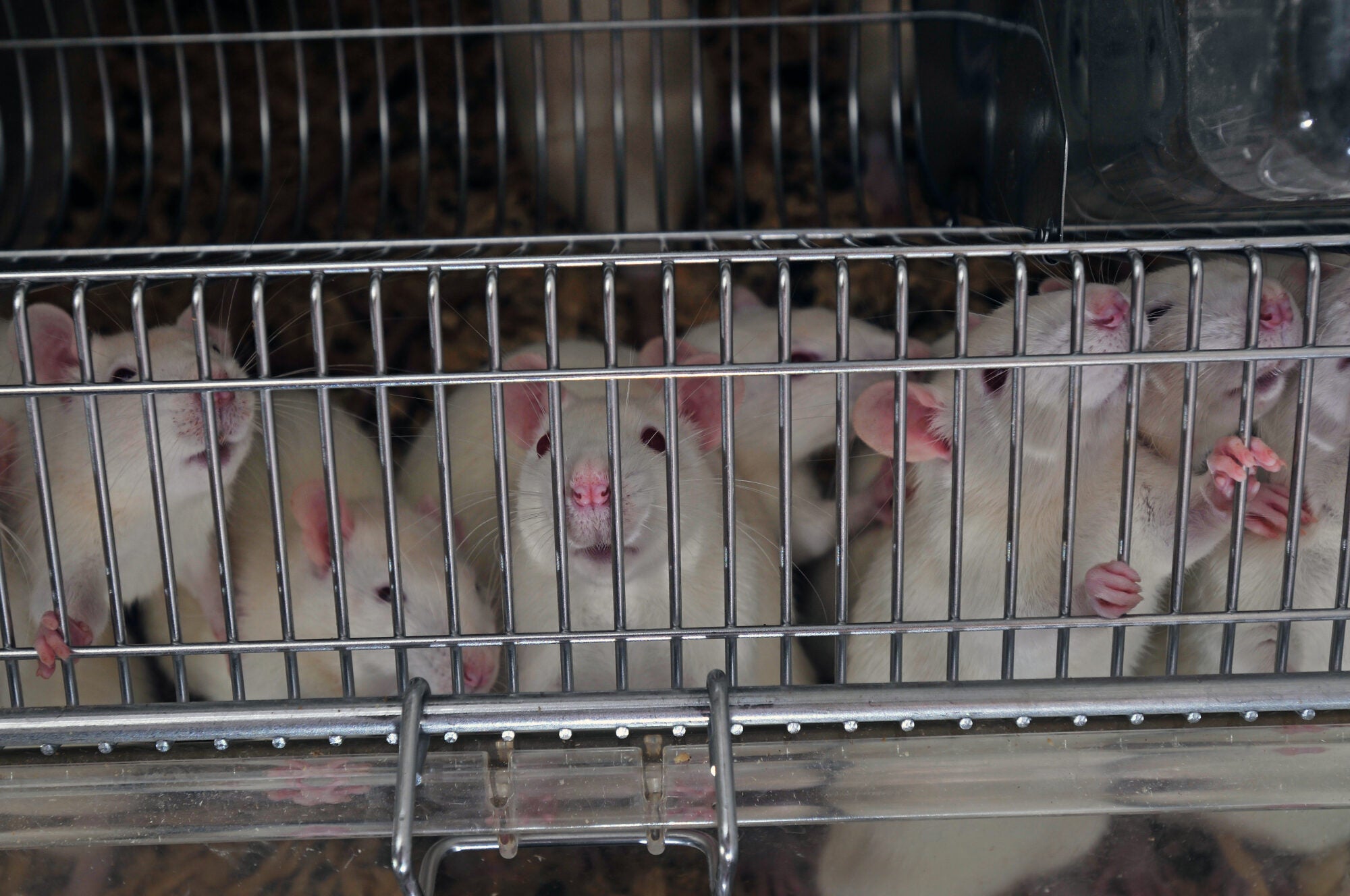
What is animal testing?
The term “animal testing” refers to procedures performed on living animals for purposes of research into basic biology and diseases, assessing the effectiveness of new medicinal products, and testing the human health and/or environmental safety of consumer and industry products such as cosmetics, household cleaners, food additives, pharmaceuticals and industrial/agro-chemicals. All procedures, even those classified as “mild,” have the potential to cause the animals physical as well as psychological distress and suffering. Often the procedures can cause a great deal of suffering. Most animals are killed at the end of an experiment, but some may be re-used in subsequent experiments. Here is a selection of common animal procedures:
- Forced chemical exposure in toxicity testing, which can include oral force-feeding, forced inhalation, skin or injection into the abdomen, muscle, etc.
- Exposure to drugs, chemicals or infectious disease at levels that cause illness, pain and distress, or death
- Genetic manipulation, e.g., addition or “knocking out” of one or more genes
- Ear-notching and tail-clipping for identification
- Short periods of physical restraint for observation or examination
- Prolonged periods of physical restraint
- Food and water deprivation
- Surgical procedures followed by recovery
- Infliction of wounds, burns and other injuries to study healing
- Infliction of pain to study its physiology and treatment
- Behavioural experiments designed to cause distress, e.g., electric shock or forced swimming
- Other manipulations to create “animal models” of human diseases ranging from cancer to stroke to depression
- Killing by carbon dioxide asphyxiation, neck-breaking, decapitation, or other means
What types of animals are used?
Many different species are used around the world, but the most common include mice, fish, rats, rabbits, guinea pigs, hamsters, farm animals, birds, cats, dogs, mini-pigs, and non-human primates (monkeys, and in some countries, chimpanzees). Video: Watch what scientists have to say about alternatives to animal testing.
It is estimated that more than 115 million animals worldwide are used in laboratory experiments every year. But because only a small proportion of countries collect and publish data concerning animal use for testing and research, the precise number is unknown. For example, in the United States, up to 90 percent of the animals used in laboratories (purpose-bred rats, mice and birds, fish, amphibians, reptiles and invertebrates) are excluded from the official statistics, meaning that figures published by the U.S. Department of Agriculture are no doubt a substantial underestimate.
Within the European Union, more than 12 million animals are used each year, with France, Germany and the United Kingdom being the top three animal using countries. British statistics reflect the use of more than 3 million animals each year, but this number does not include animals bred for research but killed as “surplus” without being used for specific experimental procedures. Although these animals still endure the stresses and deprivation of life in the sterile laboratory environment, their lives are not recorded in official statistics. HSI believes that complete transparency about animal use is vital and that all animals bred, used or killed for the research industry should be included in official figures. See some animal use statistics.
What’s wrong with animal testing?
For nearly a century, drug and chemical safety assessments have been based on laboratory testing involving rodents, rabbits, dogs, and other animals. Aside from the ethical issues they pose—inflicting both physical pain as well as psychological distress and suffering on large numbers of sentient creatures—animal tests are time- and resource-intensive, restrictive in the number of substances that can be tested, provide little understanding of how chemicals behave in the body, and in many cases do not correctly predict real-world human reactions. Similarly, health scientists are increasingly questioning the relevance of research aimed at “modelling” human diseases in the laboratory by artificially creating symptoms in other animal species.
Trying to mirror human diseases or toxicity by artificially creating symptoms in mice, dogs or monkeys has major scientific limitations that cannot be overcome. Very often the symptoms and responses to potential treatments seen in other species are dissimilar to those of human patients. As a consequence, nine out of every 10 candidate medicines that appear safe and effective in animal studies fail when given to humans. Drug failures and research that never delivers because of irrelevant animal models not only delay medical progress, but also waste resources and risk the health and safety of volunteers in clinical trials.
What’s the alternative?
If lack of human relevance is the fatal flaw of “animal models,” then a switch to human-relevant research tools is the logical solution. The National Research Council in the United States has expressed its vision of “a not-so-distant future in which virtually all routine toxicity testing would be conducted in human cells or cell lines”, and science leaders around the world have echoed this view.
The sequencing of the human genome and birth of functional genomics, the explosive growth of computer power and computational biology, and high-speed robot automation of cell-based (in vitro) screening systems, to name a few, has sparked a quiet revolution in biology. Together, these innovations have produced new tools and ways of thinking that can help uncover exactly how chemicals and drugs disrupt normal processes in the human body at the level of cells and molecules. From there, scientists can use computers to interpret and integrate this information with data from human and population-level studies. The resulting predictions regarding human safety and risk are potentially more relevant to people in the real world than animal tests.
But that’s just the beginning. The wider field of human health research could benefit from a similar shift in paradigm. Many disease areas have seen little or no progress despite decades of animal research. Some 300 million people currently suffer from asthma, yet only two types of treatment have become available in the last 50 years. More than a thousand potential drugs for stroke have been tested in animals, but only one of these has proved effective in patients. And it’s the same story with many other major human illnesses. A large-scale re-investment in human-based (not mouse or dog or monkey) research aimed at understanding how disruptions of normal human biological functions at the levels of genes, proteins and cell and tissue interactions lead to illness in our species could advance the effective treatment or prevention of many key health-related societal challenges of our time.
Modern non-animal techniques are already reducing and superseding experiments on animals, and in European Union, the “3Rs” principle of replacement, reduction and refinement of animal experiments is a legal requirement. In most other parts of the world there is currently no such legal imperative, leaving scientists free to use animals even where non-animal approaches are available.
If animal testing is so unreliable, why does it continue?
Despite this growing evidence that it is time for a change, effecting that change within a scientific community that has relied for decades on animal models as the “default method” for testing and research takes time and perseverance. Old habits die hard, and globally there is still a lack of knowledge of and expertise in cutting-edge non-animal techniques.
But with HSI’s help, change is happening. We are leading efforts globally to encourage scientists, companies and policy-makers to transition away from animal use in favour of 21st century methods. Our work brings together experts from around the globe to share knowledge and best practice, improving the quality of research by replacing animals in the laboratory.
Are animal experiments needed for medical progress?
It is often argued that because animal experiments have been used for centuries, and medical progress has been made in that time, animal experiments must be necessary. But this is missing the point. History is full of examples of flawed or basic practices and ideas that were once considered state-of-the-art, only to be superseded years later by something far more sophisticated and successful. In the early 1900’s, the Wright brothers’ invention of the airplane was truly innovative for its time, but more than a century later, technology has advanced so much that when compared to the modern jumbo jet those early flying machines seem quaint and even absurd. Those early ideas are part of aviation history, but no-one would seriously argue that they represent the cutting-edge of design or human achievement. So it is with laboratory research. Animal experiments are part of medical history, but history is where they belong. Compared to today’s potential to understand the basis of human disease at cellular and molecular levels, experimenting on live animals seems positively primitive. So if we want better quality medical research, safer more effective pharmaceuticals and cures to human diseases, we need to turn the page in the history books and embrace the new chapter—21st century science.
Independent scientific reviews demonstrate that research using animals correlates very poorly to real human patients. In fact, the data show that animal studies fail to predict real human outcomes in 50 to 99.7 percent of cases. This is mainly because other species seldom naturally suffer from the same diseases as found in humans. Animal experiments rely on often uniquely human conditions being artificially induced in non-human species. While on a superficial level they may share similar symptoms, fundamental differences in genetics, physiology and biochemistry can result in wildly different reactions to both the illness and potential treatments. For some areas of disease research, overreliance on animal models may well have delayed medical progress rather than advanced it. By contrast, many non-animal replacement methods such as cell-based studies, silicon chip biosensors, and computational systems biology models, can provide faster and more human-relevant answers to medical and chemical safety questions that animal experiments cannot match.
“The claim that animal experimentation is essential to medical development is not supported by proper, scientific evidence but by opinion and anecdote. Systematic reviews of its effectiveness don’t support the claims made on its behalf” (Pandora Pound et al. British Medical Journal 328, 514-7, 2004).



